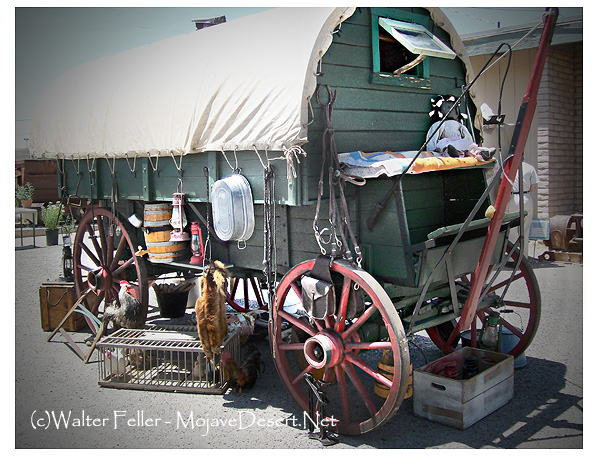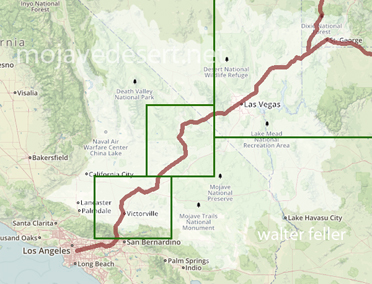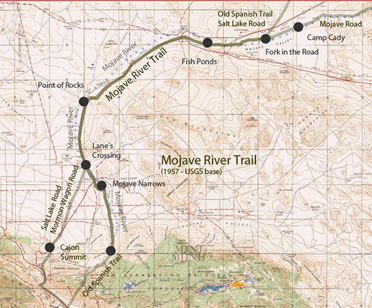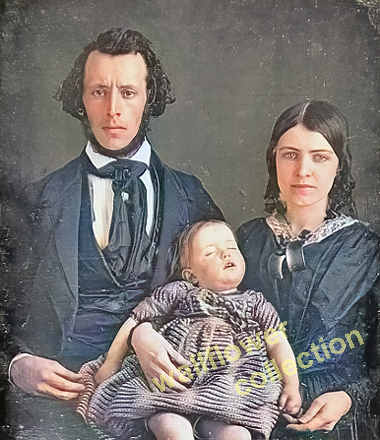Pioneers in the Mojave Desert

There were those wishing to settle in the new lands of California, they came in wagons with their
families. After
Edward F. Beale
rode to the east with news of the discovery of gold, hundreds and then
thousands came across the Mojave, at first along the
Old Spanish Trail.
 Mormons made significant use of the trail and variations became known as the Mormon Trail.
Mormons made significant use of the trail and variations became known as the Mormon Trail.
Wagon parties of note during this period were the Bennett-Arcane party and Rose-Bailey. Bennett-Arcane
had decided to try an ambiguous short-cut which ended in stranding them in Death Valley without food
or ample water. The
Rose-Bailey party
was attacked by
Mohave Indians
while attempting to cross the
the
Colorado River. Lives were lost and the Rose-Bailey party made the
long trek back to Sante Fe. The
'Lost 49ers,'
as the Bennett-Arcane party became known, were rescued
by the heroic efforts of two of its young members, William Manly and John Rogers. Although the massacre
of the Oatman family occured far to the south, Olive and Maryann Oatman were held as slaves by the Mohave
Indians for several years. Maryann died of malnutrition during a famine, and
Olive Oatman
was eventually rescued.
American Pioneers and the Westward Migration
The westward migration of American pioneers played a significant role in shaping the history and development of the United States. From the early 19th century until the end of the 19th century, millions of pioneers embarked on a remarkable journey across the vast expanse of the American West, seeking new opportunities, land, and a better life.The concept of Manifest Destiny, the belief that it was America's divine destiny to expand its territory from coast to coast, fueled the westward movement. Pioneers from various backgrounds, including farmers, miners, merchants, and families, left their homes in the East and ventured into the unknown, facing numerous challenges along the way.
The journey westward was arduous and often perilous. Pioneers faced harsh weather conditions, rugged terrain, and the constant threat of Native American attacks. They traveled in covered wagons, known as Conestoga wagons, which were loaded with essential supplies such as food, water, tools, and ammunition. Oxen or horses pulled these wagons and typically formed wagon trains for protection and mutual assistance.
The pioneers followed several major trails, including the Oregon Trail, California Trail, and Santa Fe Trail. These trails stretched for thousands of miles, crossing mountains, deserts, and rivers. The pioneers had to ford treacherous rivers, endure scorching heat, and navigate through dense forests. Along the way, they established temporary camps and trading posts to rest, resupply, and repair their wagons.
As the pioneers moved further west, they encountered vast unexplored territories and diverse landscapes. They witnessed the breathtaking beauty of the Rocky Mountains, the Great Plains' vastness, and the Sierra Nevada's grandeur. They encountered wildlife such as bison, elk, and wolves and experienced the challenges of hunting for food and protecting themselves from predators.
The westward migration brought significant changes to the American West. Pioneers established new settlements and towns, laid the foundations for future cities, and cultivated agricultural land. They built roads, bridges, and infrastructure, transforming the once untamed wilderness into a thriving civilization. The discovery of gold in California and other western territories sparked a gold rush, attracting thousands of fortune seekers and further accelerating westward expansion.
However, the westward migration also had devastating consequences for Native American tribes. As pioneers moved into their ancestral lands, conflicts arose, leading to displacement, violence, and the loss of Native American cultures. The westward expansion also destroyed natural habitats and ecosystems, impacting the environment and wildlife.
Despite the challenges and conflicts, the westward migration of American pioneers remains a significant chapter in American history. It embodied the spirit of exploration, adventure, and perseverance that defined the American frontier. The legacy of these pioneers lives on in the cities, towns, and communities they established, and their contributions continue to shape the cultural, economic, and political landscape of the United States.
In conclusion, the westward migration of American pioneers was a monumental undertaking that shaped the destiny of the United States. Through their courage, determination, and resilience, these pioneers paved the way for progress and expansion, leaving an indelible mark on the American West and the nation as a whole.
Wagon Roads
Rose-Bailey Wagon Train
Too impatient to wait for the new road to be completed, two wagon trains of emigrants left Santa Fe in 1858 to try it out, one headed by L. R. Rose, and following it another led by Gillum Bailey. ...The Life and Times of Aaron G. Lane
He had barely settled in before his ranch was raided by Indians. Other attacks followed throughout the years, and once he was even forced to ...Pratt Party
Pioneers
Captain Jefferson HuntHunt guided several parties of gold prospectors from Utah to California. Many of the pioneers he led in the 1849 ...
William Lewis Manly
The trail the "Lost 49er's" attempted to blaze led them into the fiery gates of Hell, ...
Aaron G. Lane
Captain A. G. Lane, the first permanent settler on the High Desert. In 1858 Lane located at a spot about one-half mile below ...
Olive Oatman
Also see:
Old Spanish Trail
Isaac Slover
Seeing the Elephant

Old Spanish Trail

Mojave Road

Mojave River Trail
Mormon Pioneers
The history of the Mormon Trail cannot be understood without an awareness of the Mormon religion itself. The great Mormon migration of 1846-1847 was but one step in the Mormons' quest for religious freedom and growth. ...The Lost 49'ers
The first two weeks of travel on the Old Spanish Trail were easy, but the going was slower than most of the travelers wanted. The leader of the group, Captain Jefferson Hunt, would only ...